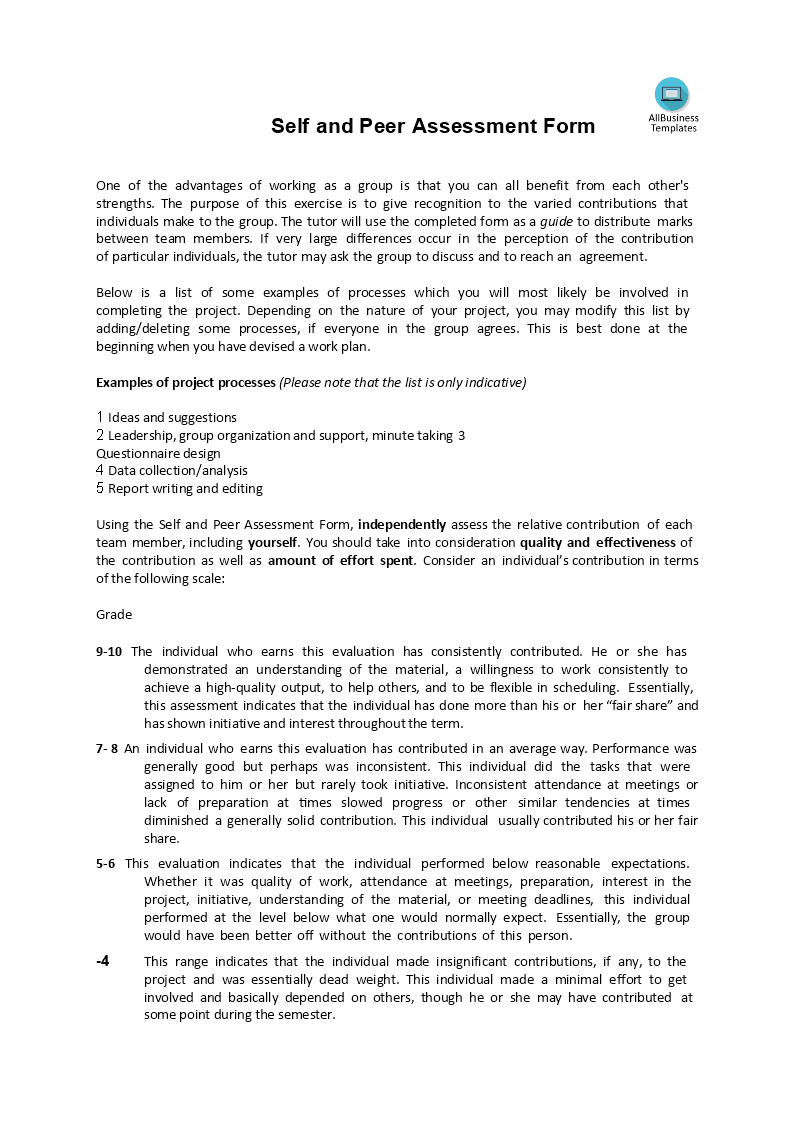Peer And Self Assessment Form
Sponsored Link免费模板 保存,填空,打印,三步搞定!

Download Peer And Self Assessment Form
微软的词 (.docx)免费文件转换
- 本文档已通过专业认证
- 100%可定制
- 这是一个数字下载 (33.02 kB)
- 语: English
Sponsored Link
What should I include in a Peer and Self Assessment Form? For better understanding, how can peer and self-assessments be used? Our template provides an easy way to assess yourself, your team, and your projects to ensure you are on the right track. It also allows you to identify areas of improvement and areas for celebration.
This form is designed to help employees and managers evaluate performance in a more objective manner. Take a look at this template for a peer and self-assessment form! Drafting a Peer and Self Assessment Form is a structured process that involves creating a document that allows individuals to evaluate themselves and their peers based on predefined criteria or performance standards. These forms are commonly used in educational settings, team projects, and professional development contexts.
Here are steps to help you draft a Peer and Self Assessment Form:
- Define the Purpose and Criteria:
- Determine the purpose of the assessment. Are you evaluating teamwork, individual contributions, specific skills, or overall performance?
- Identify the criteria or performance standards that will be assessed. Criteria should be specific, measurable, and relevant to the context.
- Decide on the Assessment Scale:
- Choose a scale for assessing each criterion. Common options include numerical scales (e.g., 1 to 5) or descriptive scales (e.g., poor, fair, good, excellent).
- Create Sections for Self and Peer Evaluation:
- Divide the form into two sections: one for self-assessment and one for peer assessment.
- Each section should include the same set of criteria and assessment scales.
- Header Information:
- At the top of the form, include:
- Title: "Peer and Self Assessment Form"
- Name of the person being assessed (if applicable).
- Name of the assessor (for peer assessment).
- Date of assessment.
- Criterion and Scale Presentation:
- List each criterion clearly. For each criterion, provide space for the assessor to:
- Select or mark the chosen rating on the scale.
- Provide comments or feedback explaining the rating.
- Instructions:
- Include clear and concise instructions for completing the form. Explain the purpose, how to use the assessment scale, and any specific guidance for providing feedback.
- Weighting (Optional):
- If certain criteria are more important than others, consider adding a weighting or point allocation system to emphasize their significance in the assessment.
- Open-Ended Questions (Optional):
- Include open-ended questions that encourage assessors to provide qualitative feedback or suggestions for improvement. For example:
- "What are the strengths of your own performance/team member's performance in this area?"
- "What areas do you or your team member need to work on?"
- Signature and Acknowledgment (Optional):
- Include a section for assessors and those being assessed to sign, indicating that they have reviewed the assessments and comments.
- Test the Form:
- Before finalizing the form, test it with a small group to ensure clarity and usability. Make any necessary adjustments based on feedback.
- Formatting and Design:
- Ensure the form is well-structured, organized, and easy to read. Use consistent formatting for all criteria and scales.
- Review for Clarity and Objectivity:
- Check that the criteria are clearly defined and free from bias. Assessments should be objective and based on observable behaviors or outcomes.
- Finalize the Form:
- Once you've made any necessary revisions based on testing and feedback, create a polished, final version of the Peer and Self Assessment Form.
- Distribution and Collection:
- Distribute the form to the assessors and those being assessed according to your assessment process.
- Set a deadline for completed forms to be collected.
- Analysis and Feedback:
- After collecting the assessments, analyze the data and provide feedback to the individuals being assessed. Use the information to identify strengths and areas for improvement.
- Continuous Improvement:
- Continuously review and update the Peer and Self Assessment Form to improve its effectiveness and relevance over time.
Remember that the design of the form should align with your assessment objectives and the context in which it will be used. Adapt the form as needed to suit the specific goals of the assessment process.
This Peer And Self Assessment Form has ways to grab your reader’s attention. It is drafted by HR professionals, intelligently structured, and easy to navigate through. Pay close attention to the most downloaded HR templates that fit your needs.
Download this Human Resources Peer And Self Assessment Form template now!
Also interested in other HR templates? Browse through our database and have instant access to hundreds of free and premium HR documents, HR forms, HR agreements, etc
DISCLAIMER
Nothing on this site shall be considered legal advice and no attorney-client relationship is established.
发表评论。 如果您有任何问题或意见,请随时在下面发布
相关文件
Sponsored Link

